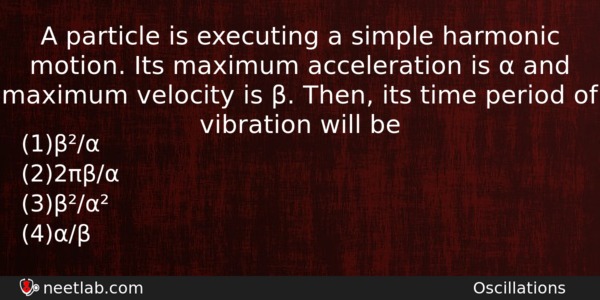| ⇦ | 
| ⇨ |
A particle is executing a simple harmonic motion. Its maximum acceleration is α and maximum velocity is β. Then, its time period of vibration will be
Options
(a) β²/α
(b) 2πβ/α
(c) β²/α²
(d) α/β
Correct Answer:
2πβ/α
Explanation:
As, we know, in Simple Harmonic Motion
Maximum acceleration of the particle, α = Aω²
Maximum velocity, β = Aω
⇒ ω = α / β
⇒ T = 2π / ω = 2πβ / α [Since, ω = 2π / T].
Related Questions: - A source of sound and a detector are moving along the same line with same speed
- A man throws balls with the same speed vertically upwards one after the other
- A radioactive nucleus emits a beta particle. The parent and daughter nuclei are
- A thin wire of resistance 4 ohm is bent to form a circle. The resistance across
- A nucleus with mass number 220 initially at rest emits an α-particle. If the Q-value
Topics: Oscillations
(58)
Subject: Physics
(2479)
Important MCQs Based on Medical Entrance Examinations To Improve Your NEET Score
- A source of sound and a detector are moving along the same line with same speed
- A man throws balls with the same speed vertically upwards one after the other
- A radioactive nucleus emits a beta particle. The parent and daughter nuclei are
- A thin wire of resistance 4 ohm is bent to form a circle. The resistance across
- A nucleus with mass number 220 initially at rest emits an α-particle. If the Q-value
Topics: Oscillations (58)
Subject: Physics (2479)
Important MCQs Based on Medical Entrance Examinations To Improve Your NEET Score
18000+ students are using NEETLab to improve their score. What about you?
Solve Previous Year MCQs, Mock Tests, Topicwise Practice Tests, Identify Weak Topics, Formula Flash cards and much more is available in NEETLab Android App to improve your NEET score.
Share this page with your friends

Leave a Reply